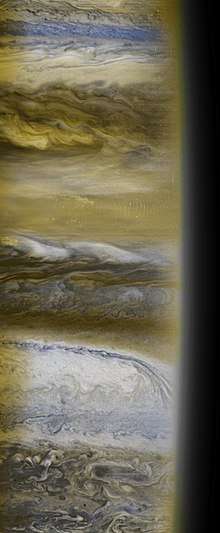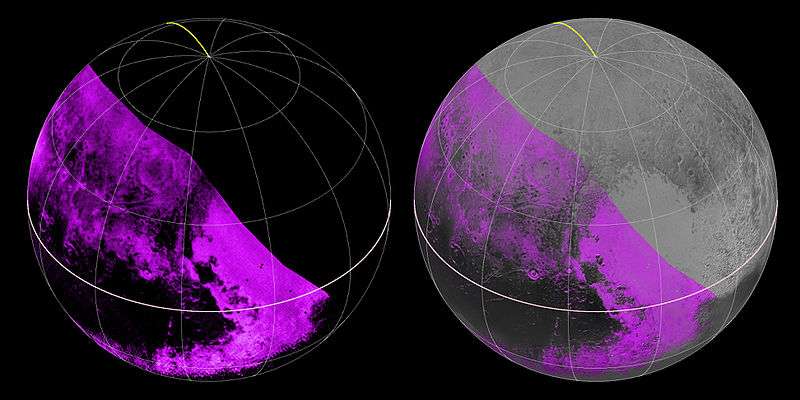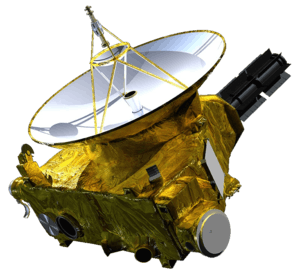Ralph (New Horizons)

Ralph is a science instrument aboard the unmanned New Horizons spacecraft, which was launched in 2006.[1] Ralph is a visible and infrared imager and spectrometer to provide maps of relevant astronomical targets based on data from that hardware.[2] Ralph has two major subinstruments, LEISA and MVIC.[3] MVIC stands for Multispectral Visible Imaging Camera and is a color imaging device, while LEISA stood for Linear Etalon Imaging Spectral Array and is an infrared imaging spectrometer for spaceflight.[4] LEISA observes 250 discrete wavelengths of infrared light from 1.25 to 2.5 micrometers light wavelengths.[5]
Ralph is one of seven major instruments aboard New Horizons which was launched in 2006 and flew-by dwarf planet Pluto in 2015.[6][7]
At Pluto, Ralph enables the observation of many aspects including:[8]
- geology
- form
- structure
- surface composition
- surface temperature
Ralph and Alice were used to characterize the Atmosphere of Pluto in 2015.[9] Ralph was previously used to observer planet Jupiter and its moons in 2006 and in 2007 when flewby en route out of the Solar System and past Pluto.[10][11] Observations of Jupiter were taken with Ralph in February 2007, when New Horizons was about 6 million kilometers (nearly 4 million miles) from the giant.[12]
It is planned that Ralph will observe MU69 on the planned flyby with closest approach planned for new year's day 2019.[13] It is reported Ralph in conjunction with LORRI telescope will be used to make digital elevation map of the body.[14] (see also (486958) 2014 MU69 ('Ultima Thule')
Naming
Ralph is named after a character in the The Honeymooners (a 1950s television show),[15] along with another New Horizon's instrument Alice.[16]
LEISA's acronym was retitled from Linear Etalon Imaging Spectral Array to Lisa Hardaway Infrared Mapping Spectrometer by NASA in June 2017, after Ralph's program manager.[17]
Methane observations
An example of Ralph's abilities is shown by this detection of methane on the surface of Pluto, overlayed on an image from a camera instrument:

Specifications
Specs:[18]
- Mass— 10.5 kg (23.1 pounds)
- Max power use— 7.1 watts
- Telescope design
- unobscurred
- off-axis
- three-mirror anastigmat
- Aperture 75 mm [19]
- f/8.7[20]
- Effective focal length 658 mm
- Electronic control boards[21]
- Detector electronics (DE)
- Command and data handling (C&DH)
- Low voltage power supply (LVPS).
The one telescope feeds light to both LEISA and MVIC channels, with light split by a dichroic beamsplitter.[22][23]
See also
- UVS (Juno) (Ultraviolet imaging spectrometer on Juno Jupiter orbiter)
- Jovian Infrared Auroral Mapper (Infrared imaging on Juno orbiter)
- Compact Reconnaissance Imaging Spectrometer for Mars
References
- ↑ Talbert, Tricia (2015-03-25). "Spacecraft and Instruments". NASA. Retrieved 2018-10-11.
- ↑ Talbert, Tricia (2015-03-25). "Spacecraft and Instruments". NASA. Retrieved 2018-10-11.
- ↑
- ↑ Weaver, et al - Overview of the New Horizons Science Payload
- ↑
- ↑ "Pluto | New Horizons | Exploring the Planets | National Air and Space Museum". airandspace.si.edu. Retrieved 2018-10-11.
- ↑ "New Horizons' Dramatic Journey to Pluto Revealed in New Book". Space.com. Retrieved 2018-10-11.
- ↑ "Meet Ralph, the New Horizons Camera Bringing Pluto into Sharp Focus - SpaceNews.com". SpaceNews.com. 2015-07-11. Retrieved 2018-10-11.
- ↑ "New Horizons begins Pluto observations ahead of July flyby – NASASpaceFlight.com". www.nasaspaceflight.com. Retrieved 2018-10-11.
- ↑ "NASA - Jupiter Ahoy!". www.nasa.gov. George Diller : KSC. Retrieved 2018-10-11.
- ↑ "NASA - A Look From LEISA". www.nasa.gov. Retrieved 2018-10-11.
- ↑ "NASA - A Look From LEISA". www.nasa.gov. Retrieved 2018-10-11.
- ↑
- ↑
- ↑ "The Museum of Broadcast Communications - Encyclopedia of Television - Honeymooners, The". www.museum.tv. Retrieved 2018-10-11.
- ↑ Gipson, Lillian (2017-06-23). "NASA's New Horizons Mission Honors Memory of Engineer Lisa Hardaway". NASA. Retrieved 2018-10-11.
- ↑ Gipson, Lillian, ed. (June 23, 2017). "NASA's New Horizons Mission Honors Memory of Engineer Lisa Hardaway". NASA. Retrieved June 27, 2017.
- ↑
- ↑
- ↑
- ↑
- ↑
- ↑
External links
| Wikimedia Commons has media related to Ralph telescope. |
